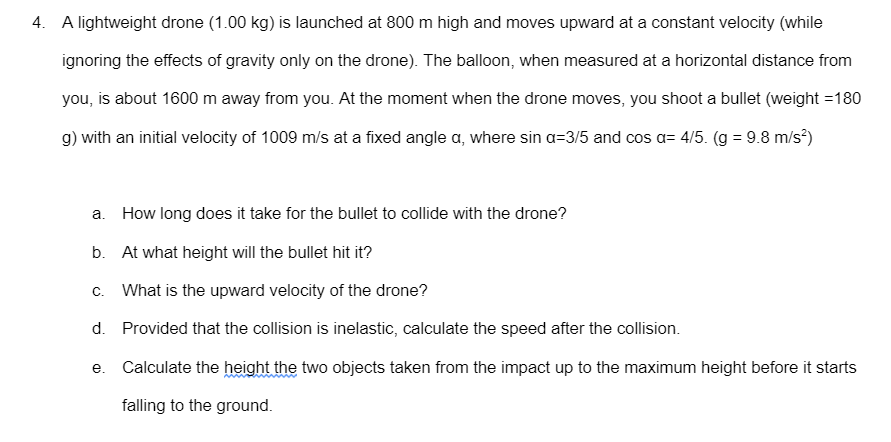4. A lightweight drone (1.00 kg) is launched at 800 m high and moves upward at a constant velocity (while ignoring the effects of gravity only on the drone). The balloon, when measured at a horizontal distance from you, is about 1600 m away from you. At the moment when the drone moves, you shoot a bullet (weight =18 g) with an initial velocity of 1009 m/s at a fixed angle a, where sin a=3/5 and cos a= 4/5. (g = 9.8 m/s?)
4. A lightweight drone (1.00 kg) is launched at 800 m high and moves upward at a constant velocity (while ignoring the effects of gravity only on the drone). The balloon, when measured at a horizontal distance from you, is about 1600 m away from you. At the moment when the drone moves, you shoot a bullet (weight =18 g) with an initial velocity of 1009 m/s at a fixed angle a, where sin a=3/5 and cos a= 4/5. (g = 9.8 m/s?)
Physics for Scientists and Engineers: Foundations and Connections
1st Edition
ISBN:9781133939146
Author:Katz, Debora M.
Publisher:Katz, Debora M.
Chapter8: Conservation Of Energy
Section: Chapter Questions
Problem 84PQ
Related questions
Question
letter d and e

Transcribed Image Text:4. A lightweight drone (1.00 kg) is launched at 800 m high and moves upward at a constant velocity (while
ignoring the effects of gravity only on the drone). The balloon, when measured at a horizontal distance from
you, is about 1600 m away from you. At the moment when the drone moves, you shoot a bullet (weight =180
g) with an initial velocity of 1009 m/s at a fixed angle a, where sin a=3/5 and cos a= 4/5. (g = 9.8 m/s)
a. How long does it take for the bullet to collide with the drone?
b. At what height will the bullet hit it?
c. What is the upward velocity of the drone?
d. Provided that the collision is inelastic, calculate the speed after the collision.
e. Calculate the height the two objects taken from the impact up to the maximum height before it starts
falling to the ground.
Expert Solution
This question has been solved!
Explore an expertly crafted, step-by-step solution for a thorough understanding of key concepts.
Step by step
Solved in 4 steps

Knowledge Booster
Learn more about
Need a deep-dive on the concept behind this application? Look no further. Learn more about this topic, physics and related others by exploring similar questions and additional content below.Recommended textbooks for you

Physics for Scientists and Engineers: Foundations…
Physics
ISBN:
9781133939146
Author:
Katz, Debora M.
Publisher:
Cengage Learning

Physics for Scientists and Engineers, Technology …
Physics
ISBN:
9781305116399
Author:
Raymond A. Serway, John W. Jewett
Publisher:
Cengage Learning

Principles of Physics: A Calculus-Based Text
Physics
ISBN:
9781133104261
Author:
Raymond A. Serway, John W. Jewett
Publisher:
Cengage Learning

Physics for Scientists and Engineers: Foundations…
Physics
ISBN:
9781133939146
Author:
Katz, Debora M.
Publisher:
Cengage Learning

Physics for Scientists and Engineers, Technology …
Physics
ISBN:
9781305116399
Author:
Raymond A. Serway, John W. Jewett
Publisher:
Cengage Learning

Principles of Physics: A Calculus-Based Text
Physics
ISBN:
9781133104261
Author:
Raymond A. Serway, John W. Jewett
Publisher:
Cengage Learning

Glencoe Physics: Principles and Problems, Student…
Physics
ISBN:
9780078807213
Author:
Paul W. Zitzewitz
Publisher:
Glencoe/McGraw-Hill